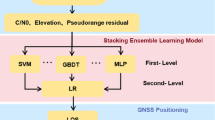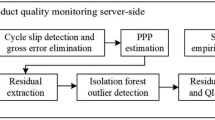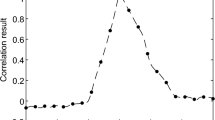Abstract
Recently, the factor graph-based global navigation satellite systems (GNSS) positioning methods have attracted much attention for more robust positioning performance in urban canyons compared with the traditional filter-based method. In the existing factor graph optimization (FGO)-based GNSS positioning methods, the pseudorange and Doppler measurements are mainly utilized to construct factors among consecutive GNSS epochs for outlier resisting and robust localization. However, the potential of high-precision positioning by using carrier phase observations is not fully explored. A factor graph optimization-based multi-GNSS real-time kinematic (FGO-RTK) framework is proposed to fill this gap, aiming to realize robust and precise positioning in urban canyons. In our method, a sliding window-based FGO estimator is designed, in which the continuously tracked double difference ambiguities are used to establish the ambiguity constraints of position states that have common-view satellites within the window. A marginalization-based carrier phase ambiguity propagation (AP) method is developed to fully use the information of carrier phase observations for achieving more reliable and continuous ambiguity resolution. Experiments in both medium urban and deep urban environments verified the effectiveness of the proposed method. Results show that FGO-RTK (with or without the AP) can achieve centimeter-level positioning accuracy in medium urban situations, showing comparable performance with the traditional extended Kalman filter (EKF)-based RTK. With the GNSS observation conditions deteriorating in deep urban environments, FGO-RTK without AP cannot outperform EKF-RTK. By contrast, the proposed FGO-RTK, considering the AP, achieves significant improvements in centimeter- to decimeter-level positioning availability, and the 3D positioning accuracy is improved by 69.6%, compared with the EKF-RTK. Furthermore, by analyzing the impact of the window size against the performance of FGO-RTK, we found that in comparison to the FGO-RTK only using the carrier phase observations inside a fixed-size window, the proposed AP method can significantly reduce the dependence on window size, and the optimal window size can be reduced from 10 to 4 epochs with more than 50% optimization time decreasing.













Similar content being viewed by others
Data availability
The data that support the results of this study are available from the corresponding author for academic purposes on reasonable request.
References
Agarwal S, Mierle K (2019) Ceres solver—a large scale nonlinear optimization library. http://www.ceres-solver.org. Accessed 12 July 2022
Bai X, Wen W, Hsu LT (2022) Time-correlated window carrier-phase aided GNSS positioning using factor graph optimization for urban positioning. IEEE Trans Aerosp Electron Syst 58:3370–3384
Blewitt G (1990) An automatic editing algorithm for GPS data. Geophys Res Lett 17(3):199–202
Chen Y, Zhao S, Farrell JA (2015) Computationally efficient carrier integer ambiguity resolution in multi-epoch GPS/INS: a common-position-shift approach. IEEE Trans Control Syst Technol 24(5):1541–1556
Dellaert F, Kaess M (2017) Factor graphs for robot perception. Found Trends Robot 6(1–2):1–139
Gao H, Li H, Huo H, Yang C (2022) Robust GNSS real-time Kinematic with ambiguity resolution in factor graph optimization. In: Proceeding of ION ITM 2022, Institute of Navigation, California, USA, January 25–27, pp 835–843
Ge M, Gendt G, Rothacher MA, Shi C, Liu J (2008) Resolution of GPS carrier-phase ambiguities in precise point positioning (PPP) with daily observations. J Geod 82(7):389–399
Gendt G, Dick G, Reigber C, Tomassini M, Liu Y, Ramatschi M (2003) Demonstration of NRT GPS water vapor monitoring for numerical weather prediction in Germany. J Meteorol Soc Jpn 82:360–370
Han S (1997) Quality-control issues relating to instantaneous ambiguity resolution for real-time GPS kinematic positioning. J Geod 71(6):351–361
He K (2015) GNSS kinematic position and velocity determination for airborne gravimetry. Technische Universitaet Berlin, Berlin Germany
Iwase T, Kojima Y, Teramoto E (2012) M-epoch ambiguity resolution technique for single frequency receivers with INS aid. In: Proceeding of IEEE/ION PLANS 2012, Institute of Navigation, SC, USA, April 23–26, pp 706–710
Jurić A, Kendeš F, Marković I, Petrović I (2021) A comparison of graph optimization approaches for pose estimation in SLAM. In: Proceedings of the international convention MIPRO, Opatija, Croatia, Sept 27–Oct 01, pp 1113–1118
Li J, Yang Y, Xu J, He H, Guo H (2015a) GNSS multi-carrier fast partial ambiguity resolution strategy tested with real BDS/GPS dual-and triple-frequency observations. GPS Solut 19(1):5–13
Li X, Zhang X, Ren X, Fritsche M, Wickert J, Schuh H (2015b) Precise positioning with current multi-constellation global navigation satellite systems: GPS, GLONASS, Galileo, and BeiDou. Sci Rep 5(1):1–14
Li X, Li X, Liu G, Xie W, Guo F, Yuan Y, Zhang K, Feng G (2020) The phase and code biases of Galileo and BDS-3 BOC signals: effect on ambiguity resolution and precise positioning. J Geod 94(1):1–14
Li X, Wang X, Liao J, Li X, Li S, Lyu H (2021) Semi-tightly coupled integration of multi-GNSS PPP and S-VINS for precise positioning in GNSS-challenged environments. Satell Navig 2(1):1–14
Nocedal J, Wright SJ (2006) Numerical optimization, 2nd edn. Springer, Cham
NovAtel Corporation (2020) Waypoint Software 8.90 user manual v10. https://docs.novatel.com/Waypoint/Content/Home.htm. Accessed 13 June 2023
Odijk D, Wanninger L (2017) Differential positioning. Springer handbook of global navigation satellite systems. Springer, Cham, pp 753–780
Realini E, Reguzzoni M (2013) goGPS: open source software for enhancing the accuracy of low-cost receivers by single-frequency relative kinematic positioning. Meas Sci Technol 24(11):115010
Schmid R, Steigenberger P, Gendt G, Ge M, Rothacher M (2007) Generation of a consistent absolute phase-center correction model for GPS receiver and satellite antennas. J Geod 81(12):781–798
Sibley G, Matthies L, Sukhatme G (2010) Sliding window filter with application to planetary landing. J Field Robot 27(5):587–608
Strasdat H, Montiel JM, Davison AJ (2012) Visual SLAM: why filter? Image Vis Comput 30(2):65–77
Sünderhauf N, Protzel P (2012) Towards robust graphical models for GNSS-based localization in urban environments. In: Proceedings of the international multi-conference on systems, signals & devices, Chemnitz, Germany, March 20–23, pp 1–6
Teunissen PJG (1995) The least-squares ambiguity decorrelation adjustment: a method for fast GPS integer ambiguity estimation. J Geod 70(1–2):65–82
Teunissen PJG (1993) Least-squares estimation of the integer GPS ambiguities. In: Invited lecture, section IV theory and methodology, IAG general meeting, Beijing, China, pp 1–16
Watson RM, Gross JN (2018) Evaluation of kinematic precise point positioning convergence with an incremental graph optimizer. In: Proceeding of IEEE/ION PLANS 2018, Institute of Navigation, Monterey, USA, April 23–26, 589–596
Wen W, Pfeifer T, Bai X, Hsu LT (2020) Comparison of extended Kalman filter and factor graph optimization for GNSS/INS integrated navigation system. J Inst Navig 68(2):10572
Wen W, Hsu LT (2021) Towards robust GNSS positioning and real-time kinematic using factor graph optimization. In: Proceedings of the international conference on robotics and automation (ICRA), Xi’an, China, May 30–June 05, pp 5884–5890
Wu JT, Wu SC, Hajj GA, Bertiger WI, Lichten SM (1992) Effects of antenna orientation on GPS carrier phase. Astrodynamics 1991:1647–1660
Acknowledgements
Our algorithm implementation is based on the GREAT (GNSS+REsearch, Application, and Teaching) software developed by the GREAT Group, School of Geodesy and Geomatics, Wuhan University. The numerical calculations (e.g., base station coordinates) in this paper have been done on the supercomputing system in the Supercomputing Center of Wuhan University.
Funding
This work was supported in part by the National Key Research and Development Program of China (2021YFB2501102), the National Natural Science Foundation of China (Grant 41974027), and the Sino-German mobility program (Grant No. M-0054).
Author information
Authors and Affiliations
Contributions
Xuanbin Wang and Xingxing Li contributed to the study conception and design. Material preparation, data collection, and analysis were performed by Zhiheng Shen, Xin Li, Yuxuan Zhou, and Hanyu Chang. Xuanbin Wang wrote the first draft of the manuscript, and all authors commented on previous versions of the manuscript. All authors read and approved the final manuscript.
Corresponding author
Ethics declarations
Competing interests
The authors declare that they have no competing interests.
Additional information
Publisher's Note
Springer Nature remains neutral with regard to jurisdictional claims in published maps and institutional affiliations.
Rights and permissions
Springer Nature or its licensor (e.g. a society or other partner) holds exclusive rights to this article under a publishing agreement with the author(s) or other rightsholder(s); author self-archiving of the accepted manuscript version of this article is solely governed by the terms of such publishing agreement and applicable law.
About this article
Cite this article
Wang, X., Li, X., Shen, Z. et al. Factor graph optimization-based multi-GNSS real-time kinematic system for robust and precise positioning in urban canyons. GPS Solut 27, 200 (2023). https://doi.org/10.1007/s10291-023-01538-x
Received:
Accepted:
Published:
DOI: https://doi.org/10.1007/s10291-023-01538-x




